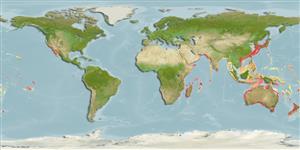>
Scombriformes (Mackerels) >
Scombridae (Mackerels, tunas, bonitos) > Scombrinae
Etymology: Scomber: Greek, skombros = tunny or mackerel, 1623 (Ref. 45335).
More on author: Cuvier.
Environment: milieu / climate zone / depth range / distribution range
Ökologie
seewasser; ozeanodrom (Ref. 51243); tiefenbereich 87 - 200 m (Ref. 9563). Subtropical; 43°N - 50°S, 32°E - 110°W (Ref. 168)
Indo-West Pacific: Red Sea, Persian Gulf; from Japan, south to Australia and New Zealand. Eastern Pacific: Hawaii and off Mexico (Socorro Island).
Size / Gewicht / Alter
Maturity: Lm ? range ? - ? cm
Max length : 44.0 cm FL Männchen/unbestimmt; (Ref. 40637); common length : 30.0 cm FL Männchen/unbestimmt; (Ref. 168); max. veröff. Gewicht: 1.4 kg (Ref. 40637)
Rückenflossenstacheln (insgesamt): 10 - 13; Rückenflossenweichstrahlen (insgesamt): 12; Afterflossenstacheln 0; Afterflossenweichstrahlen: 12; Wirbelzahl: 31. No well developed corselet but body covered with rather small scales. Palatine narrow. Anal fin origin clearly more posterior than that of second dorsal fin. Anal fin spine independent from anal fin. Swim bladder present. Snout pointed. Interpelvic process small and single. Back with narrow oblique lines which zigzag and undulate; the belly is pearly white and marked with thin, wavy broken lines.
Occurs in coastal waters (Ref. 9340) and also in oceanic waters (Ref. 9563). Minimum depth reported at 87 m (Ref. 58489); fishing depths to 265 m (cited in Ref. 58302). Schooling by size which may include jack mackerels and Pacific sardines. They are plankton feeders filtering copepods and other crustaceans, but adults also feed on small fish and squids. Also caught with encircling nets (Ref. 9340). Marketed fresh, dried-salted, smoked, canned and frozen (Ref. 9987).
Life cycle and mating behavior
Geschlechtsreife | Fortpflanzung | Ablaichen | Eier | Fecundity | Larven
Collette, B.B. and C.E. Nauen, 1983. FAO Species Catalogue. Vol. 2. Scombrids of the world. An annotated and illustrated catalogue of tunas, mackerels, bonitos and related species known to date. Rome: FAO. FAO Fish. Synop. 125(2):137 p. (Ref. 168)
IUCN Rote Liste Status (Ref. 130435)
Bedrohung für Menschen
Harmless
Nutzung durch Menschen
Fischereien: kommerziell; Sportfisch: ja; Köder: usually
Mehr Information
NamenSynonymeMetabolismusRäuberÖkotoxikologieFortpflanzungGeschlechtsreifeAblaichenSpawning aggregationFecundityEierEientwicklung
Tools
Zusatzinformationen
Download XML
Internet Quellen
Estimates based on models
Preferred temperature (Ref.
123201): 10.8 - 24.3, mean 18.7 °C (based on 185 cells).
Phylogenetic diversity index (Ref.
82804): PD
50 = 0.5625 [Uniqueness, from 0.5 = low to 2.0 = high].
Bayesian length-weight: a=0.00912 (0.00799 - 0.01041), b=3.05 (3.01 - 3.09), in cm total length, based on LWR estimates for this species (Ref.
93245).
Trophic level (Ref.
69278): 4.2 ±0.5 se; based on diet studies.
Widerstandsfähigkeit (Ref.
120179): mittel, Verdopplung der Population dauert 1,4 - 4,4 Jahre. (K=0.28).
Prior r = 0.57, 95% CL = 0.38 - 0.86, Based on 2 stock assessments.
Fishing Vulnerability (Ref.
59153): Moderate vulnerability (43 of 100).
Climate Vulnerability (Ref.
125649): Low to moderate vulnerability (30 of 100).
Nutrients (Ref.
124155): Calcium = 52.1 [17.4, 129.4] mg/100g; Iron = 2 [1, 5] mg/100g; Protein = 21 [20, 22] %; Omega3 = 0.392 [0.257, 0.600] g/100g; Selenium = 74.3 [27.5, 192.3] μg/100g; VitaminA = 24.7 [5.9, 109.4] μg/100g; Zinc = 0.822 [0.487, 1.377] mg/100g (wet weight);
